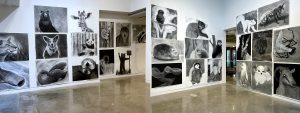Courses
Contact
Art & Art HistoryStudio Art 102 651-696-6279
651-696-6266 (fax)
artdept@macalester.edu

Student drawings on display in the Koch Gallery. ART 130 – Drawing I with Megan Vossler.
Informative Links
Art and Art History
ART 130 - Drawing I
Frequency: Every semester.
ART 131 - Ceramics I
Frequency: Offered every semester.
ART 149 - Introduction to Visual Culture
Frequency: Offered every other fall.
ART 160 - Introduction to Art History I: From Prehistory to the Medieval Period
Frequency: Every fall.
Cross-Listed as: CLAS 260
ART 161 - Introduction to Art History II: From Renaissance to Modern
Frequency: Spring semester.
ART 194 - Topics Course
ART 210 - Globalization and Contemporary Art
Frequency: Alternate fall semesters.
Cross-Listed as: INTL 210
ART 216 - Graphic Novel
Frequency: Offered occasionaly.
Cross-Listed as: ENGL 216
ART 230 - Color
Frequency: Spring semester.
ART 233 - Photography I
Frequency: Every semester.
ART 234 - Painting I
Frequency: Every semester.
ART 235 - Sculpture I
Frequency: Every semester.
ART 236 - Printmaking I
Frequency: Every semester.
ART 237 - Foundations of Ceramics Art: Pottery and Purpose
Frequency: Every semester.
ART 238 - Unconventional Clay
Frequency: Alternate years.
ART 239 - 2-D Design
Frequency: Fall semester.
ART 252 - Gender, Sexualities, and Feminist Visual Culture
Frequency: Offered every two years.
Cross-Listed as: WGSS 252
ART 253 - Transnational Surrealism: Art, Photography, and Film
Frequency: Alternate years.
ART 254 - History of Body and Performance Art
Frequency: Offered occasionally.
ART 263 - Modern Art
Frequency: Fall semester every other year.
ART 264 - Contemporary Art and Theory
Frequency: Spring semester, every other year.
ART 267 - 3-D Design
Frequency: Fall semester.
ART 269 - Art, Trade, and Treasure of the Silk Road
Frequency: Offered occasionally.
Cross-Listed as: ASIA 269
ART 270 - Making Sacred: Religious Images and Spaces in Asia
Cross-Listed as: ASIA 270
ART 272 - Art of China
Frequency: Fall semester.
Cross-Listed as: ASIA 272
ART 273 - Art of Japan
Frequency: Spring semester only.
Cross-Listed as: ASIA 273
ART 280 - Art and Architecture of Ancient Egypt
Frequency: Alternate fall semesters.
Cross-Listed as: CLAS 280
ART 281 - Art and Architecture of Ancient Western Asia
Frequency: Alternate spring semesters.
ART 282 - Art and Architecture of the Islamic World
Cross-Listed as: CLAS 282
ART 283 - Art and Architecture of Ancient Greece and Rome
Frequency: Alternate spring semesters.
Cross-Listed as: CLAS 283
ART 284 - Art and Architecture of Byzantium and Medieval Europe
Frequency: Alternate spring semesters.
ART 285 - Making of Imperial Cities: Babylon, Rome, and Constantinople
Frequency: Alternate fall semesters.
ART 294 - Topics Course
ART 327 - Japanese Art and the (Inter)National Modern
Frequency: Alternate years.
Prerequisite(s): No prerequisites required; First Years are welcome.
Cross-Listed as: ASIA 327
ART 330 - Figure Drawing
Frequency: Offered occasionally.
Prerequisite(s): ART 130 or permission of instructor.
ART 332 - Traditional and Digital Illustration
Frequency: Offered occasionally.
Prerequisite(s): ART 130
ART 333 - Photography II
Frequency: Every year.
Prerequisite(s): ART 233
ART 334 - Figure Painting
Frequency: Alternate odd years.
Prerequisite(s): ART 234 or permission of instructor.
ART 350 - The Body and Identity in Later Chinese Art
Frequency: Offered occasionally.
Cross-Listed as: ASIA 350
ART 370 - Drawing II
Frequency: Offered occasionally.
Prerequisite(s): ART 130 or permission of instructor.
ART 371 - Painting II
Frequency: Every semester.
Prerequisite(s): ART 234 .
ART 372 - Sculpture II
Frequency: Every year.
Prerequisite(s): ART 235
ART 373 - Printmaking II
Frequency: Every semester.
ART 374 - Ceramics II
Frequency: Every semester.
Prerequisite(s): ART 131 or approval of instructor.
ART 375 - Race, Ethnicity, Class, and Gender in American Art
Frequency: Offered in the fall every two years.
Prerequisite(s): At least one course in Art History, WGSS or AMST or permission of the instructor.
ART 376 - Word.
Frequency: Spring semester.
ART 380 - Art and Iconoclasm from the Ancient World to Early Modern Era
Frequency: Alternate spring semesters.
ART 394 - Topics Course
ART 487 - Art History Methodology Seminar
Frequency: Spring semester.
Prerequisite(s): Art History seniors only.
ART 488 - Senior Studio Seminar
Frequency: Spring semester.
ART 490 - Art Apprenticeship
ART 494 - Topics Course
ART 601 - Tutorial
Frequency: Every semester.
Prerequisite(s): Permission of instructor and department chair.
ART 602 - Tutorial
Frequency: Every semester.
Prerequisite(s): Permission of instructor and department chair.
ART 603 - Tutorial
Frequency: Every semester.
Prerequisite(s): Permission of instructor and department chair.
ART 604 - Tutorial
Frequency: Every semester.
Prerequisite(s): Permission of instructor and department chair.
ART 611 - Independent Project
Frequency: Every semester.
Prerequisite(s): Permission of instructor and department chair.
ART 612 - Independent Project
Frequency: Every semester.
Prerequisite(s): Permission of instructor and department chair.
ART 613 - Independent Project
Frequency: Every semester.
Prerequisite(s): Permission of instructor and department chair.
ART 614 - Independent Project
Frequency: Every semester.
Prerequisite(s): Permission of instructor and department chair.
ART 621 - Internship
Frequency: Every semester.
Prerequisite(s): Permission of instructor. Work with Internship Office.
ART 622 - Internship
Frequency: Every semester.
Prerequisite(s): Permission of instructor. Work with Internship Office.
ART 623 - Internship
Frequency: Every semester.
Prerequisite(s): Permission of instructor. Work with Internship Office.
ART 624 - Internship
Frequency: Every semester.
Prerequisite(s): Permission of instructor. Work with Internship Office.
ART 631 - Preceptorship
Frequency: Every semester.
Prerequisite(s): Permission of instructor. Work with Academic Programs.
ART 632 - Preceptorship
Frequency: Every semester.
Prerequisite(s): Permission of instructor. Work with Academic Programs.
ART 633 - Preceptorship
Frequency: Every semester.
Prerequisite(s): Permission of instructor. Work with Academic Programs.
ART 634 - Preceptorship
Frequency: Every semester.
Prerequisite(s): Permission of instructor. Work with Academic Programs.